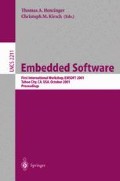Abstract
We propose in this paper a historical perspective of programming issues found in the implementation of control systems, based on the author’s observations for more than fifteen years, but especially during the Crisys Esprit project. We show that in contrast with the asynchronous tradition of computer scientists, control engineers were naturally led to a synchronous practice that was later formalised and generalised by computer people. But, we also show that, for the sake of robustness and distribution those practitioners had to incorporate some degree of asynchrony in this synchronous approach and we try to comment the resulting programming style.
Access this chapter
Tax calculation will be finalised at checkout
Purchases are for personal use only
Preview
Unable to display preview. Download preview PDF.
References
C. André. Representation and analysis of reactive behaviors: a synchronous approach. In Proc. CESA’96, Lille, July 1996.
A. Benveniste, P. LeGuernic, and Ch. Jacquemot. Synchronous programming with events and relations: the SIGNAL language and its semantics. Science of Computer Programming, 16:103–149, 1991.
J. L. Bergerand and E. Pilaud. SAGA; a software development environment for dependability in automatic control. In SAFECOMP’88. Pergamon Press, 1988.
G. Berry and G. Gonthier. The esterel synchronous programming language, design, semantics, implementation. Science of Computer Programming, 19(2):87–152, 1992.
G. Boudol, V. Roy, R. de Simone, and D. Vergamini. Process algebras and systems of communicating processes. In Automatic Verification For Finite States Systems, volume 407 of Lecture Notes in Computer Science. Springer Verlag, 1990.
D. Briére, D. Ribot, D. Pilaud, and J.L. Camus. Methods and specification tools for Airbus on-board systems. In Avionics Conference and Exhibition, London, December 1994. ERA Technology.
J. A. Brzozowski and C-J. H. Seger. Asynchronous Circuits. Springer-Verlag, 1995.
P. Caspi and R. Salem. Threshold and bounded-delay voting in critical control systems. In Mathai Joseph, editor, Formal Techniques in Real-Time and Fault-Tolerant Systems, volume 1926 of Lecture Notes in Computer Science, pages 68–81, September 2000.
A. Chatha. Fieldbus: The foundation for field control systems. Control Engineering, pages 47–50, May 1994.
N. Halbwachs, P. Caspi, P. Raymond, and D. Pilaud. The synchronous dataflow programming language lustre. Proceedings of the IEEE, 79(9):1305–1320, September 1991.
N. Halbwachs, F. Lagnier, and C. Ratel. Programming and verifying real-time systems by means of the synchronous data-flow language lustre. IEEE Transactions on Software Engineering, 18(9):785–793, september 1992.
D. Harel. Statecharts: a visual approach to complex systems. Science of Computer Programming, 8(3), 1987.
C. A. R. Hoare. Communicating sequential processes. Communication of the ACM, 21(8):666–676, 1978.
K.J.A? strÖm and B. Wittenmark. Computer Controlled Systems. Prentice-Hall, 1984.
H. Kopetz, A. Damm, Ch. Koza, M. Mulazzani, W. Schwabl, Ch. Senft, and R. Zainlinger. Distributed fault-tolerant real-time systems: the MARS approach. IEEE Micro, 9(1):25–40, 1989.
G. LeGoff. Using synchronous languages for interlocking. In First International Conference on Computer Application in Transportation Systems, 1996.
F. Maraninchi. Operational and compositional semantics of synchronous automaton compositions. In Proc. of CONCUR’92, volume 630 of Lecture Notes in Computer Science. Springer Verlag, August 1992.
S. Mauw. The formalization of message sequence charts. Computer Networks and ISDNSystems, 28:1643–1657, 1996.
R. Milner. Calculi for synchrony and asynchrony. Theoretical Computer Science, 25:267–310, 1983.
P. Caspi. What can we learn from synchronous data-flow languages. In O. Maler, editor, Hybrid and Real-Time Systems, volume 1201 of Lecture Notes in Computer Science, pages 255–258. Springer, 1997. invited conference.
Author information
Authors and Affiliations
Editor information
Editors and Affiliations
Rights and permissions
Copyright information
© 2001 Springer-Verlag Berlin Heidelberg
About this paper
Cite this paper
Caspi, P. (2001). Embedded Control: From Asynchrony to Synchrony and Back. In: Henzinger, T.A., Kirsch, C.M. (eds) Embedded Software. EMSOFT 2001. Lecture Notes in Computer Science, vol 2211. Springer, Berlin, Heidelberg. https://doi.org/10.1007/3-540-45449-7_7
Download citation
DOI: https://doi.org/10.1007/3-540-45449-7_7
Published:
Publisher Name: Springer, Berlin, Heidelberg
Print ISBN: 978-3-540-42673-8
Online ISBN: 978-3-540-45449-6
eBook Packages: Springer Book Archive

